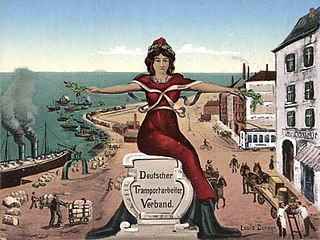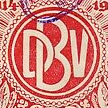Related Research Articles

The Factory Workers' Union of Germany was a trade union in Germany.
The General Commission of German Trade Unions was an umbrella body for German trade unions during the German Empire, from the end of the Anti-Socialist Laws in 1890 up to 1919. In 1919, a successor organisation was named the Allgemeiner Deutscher Gewerkschaftsbund, and then in 1949, the current Deutscher Gewerkschaftsbund was formed.

The Union of Miners of Germany was a trade union representing miners in Germany.

The German Transport Workers' Union was a trade union representing transport workers in Germany.
The German Tobacco Workers' Union was a trade union representing people in the tobacco manufacturing industry in Germany.

The German Clothing Workers' Union was a trade union representing people involved in making clothing in Germany.

The Union of Municipal and State Workers was a trade union representing public sector workers in Germany.

The German Union of Saddlers, Upholsterers and Portfolio Makers was a trade union representing leather goods and upholstery workers in Germany.
The Union of Bookbinders and Paper Workers of Germany was a trade union representing workers involved in manufacturing paper and binding books in Germany.
The International Union of Leather Workers was a global union federation representing tanners and glovemakers.
The Union of Hairdressers and Assistants was a trade union representing workers in the hairdressing industry in Germany.

The German Construction Workers' Union was a trade union representing building workers in Germany.
The Central Union of Bakers and Confectioners was a trade union that played a significant role in representing workers in bakeries and related trades in Germany.

The German Furriers' Union was a trade union representing fur workers in Germany.
The Union of Saddlers and Portfolio Makers was a trade union representing workers involved in making saddles, bags and wallets.
The Union of German Restaurant Workers was a trade union representing workers in hotels and restaurants in Germany.
Albert Regge was a German trade union leader.
The Union of Dockers of Germany was a trade union representing dock workers in Germany.
The Swiss Clothing, Leather and Equipment Workers' Union was a trade union representing workers in the clothing and leather industries.
The International Federation of Saddlers' Unions was a global union federation uniting trade unions representing workers involved in making saddles and related products.
References
- 1 2 3 4 Mahler, Heinrich (1931). Deutscher Lederarbeiter-Verband. ADGB. pp. 373–374. Retrieved 3 June 2020.
- 1 2 3 "Deutscher Lederarbeiter-Verband" (PDF). Friedrich Ebert Stiftung. Retrieved 3 June 2020.
- ↑ Deinhardt, Ernst (1907). Die Internationalen Beziehungen der Gewerkschaften . Retrieved 3 June 2020.
- ↑ Handbook of International Organizations. League of Nations. 1921. p. 100.